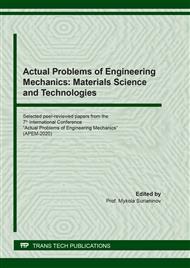p.66
p.73
p.80
p.93
p.101
p.108
p.115
p.122
p.128
Study of Pavements of Concrete Paving Blocks with Ribbed Underside Surface
Abstract:
Improving the reliability and durability of sidewalks, footways, car parks and areas for various purposes, made of concrete paving blocks (CPBs), is an important task of construction. In order to improve the quality characteristics, new pavements consisting of concrete paving blocks with a ribbed underside surface are proposed. Hypotheses about the advantages of the developed structural solutions of pavements relative to traditional pavements of blocks with a flat underside surface were formulated. To confirm the hypotheses, studies of one of the developed pavement variants of in laboratory conditions were performed. The article describes the plan and methodology for implementation two series of experiments. In the first series of the experiment, a section of a traditional pavement of concrete blocks with a flat underside surface was investigated, in the second, a section from a pavement of concrete paving blocks with a ribbed underside surface consisting of three prismatic elements. Qualitative characteristics of the pavement are determined by various indexes. As a result of laboratory tests, the dynamics of settlement of experimental CPBs under the influence of vertically applied load was studied, and density index of a sand structural layer located under the tested CPBs was also obtained. The settlement indexes of the tested CPBs were investigated for three days. A comparative analysis of the experimental results confirmed the hypothesis about the advantages of pavements of concrete paving blocks with a ribbed underside surface. For the further implementation of the developed pavement variant in the construction industry, additional research is required. Further research directions of pavements of concrete paving blocks with a modified geometric shape of the underside surface are determined.
Info:
Periodical:
Pages:
101-107
Citation:
Online since:
September 2020
Keywords:
Price:
Сopyright:
© 2020 Trans Tech Publications Ltd. All Rights Reserved
Share:
Citation:


